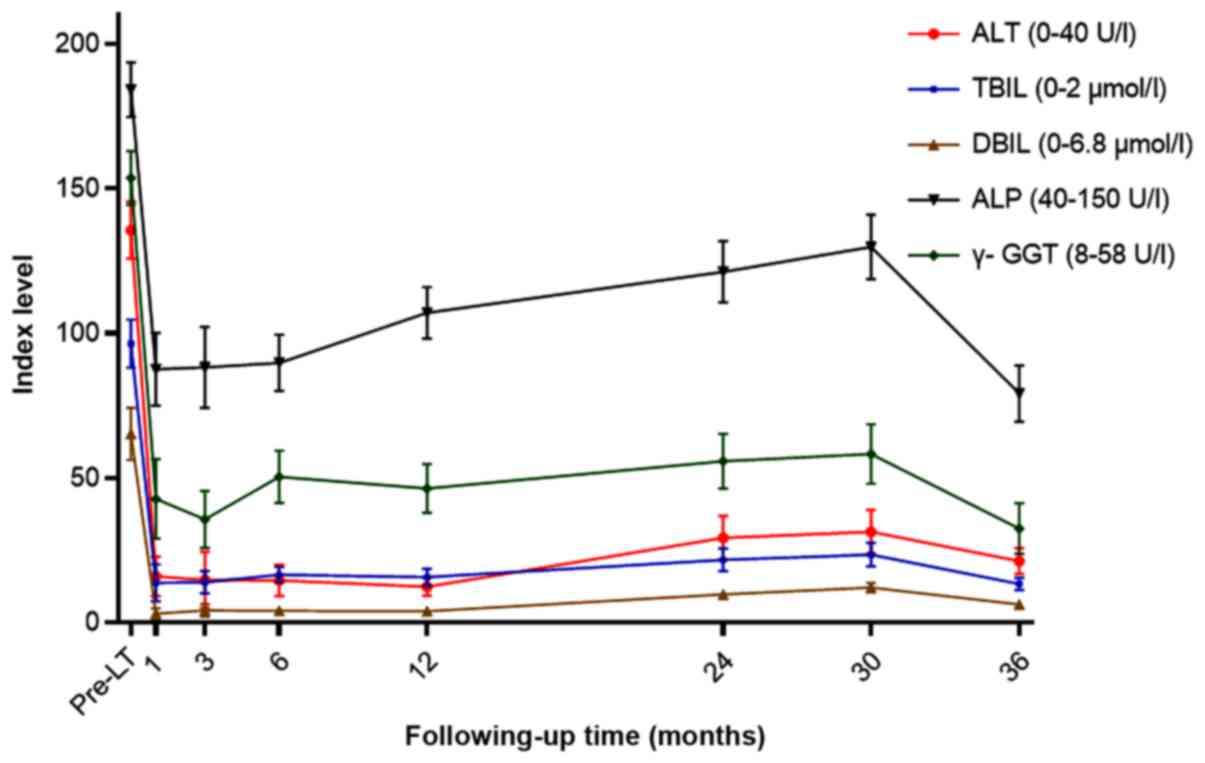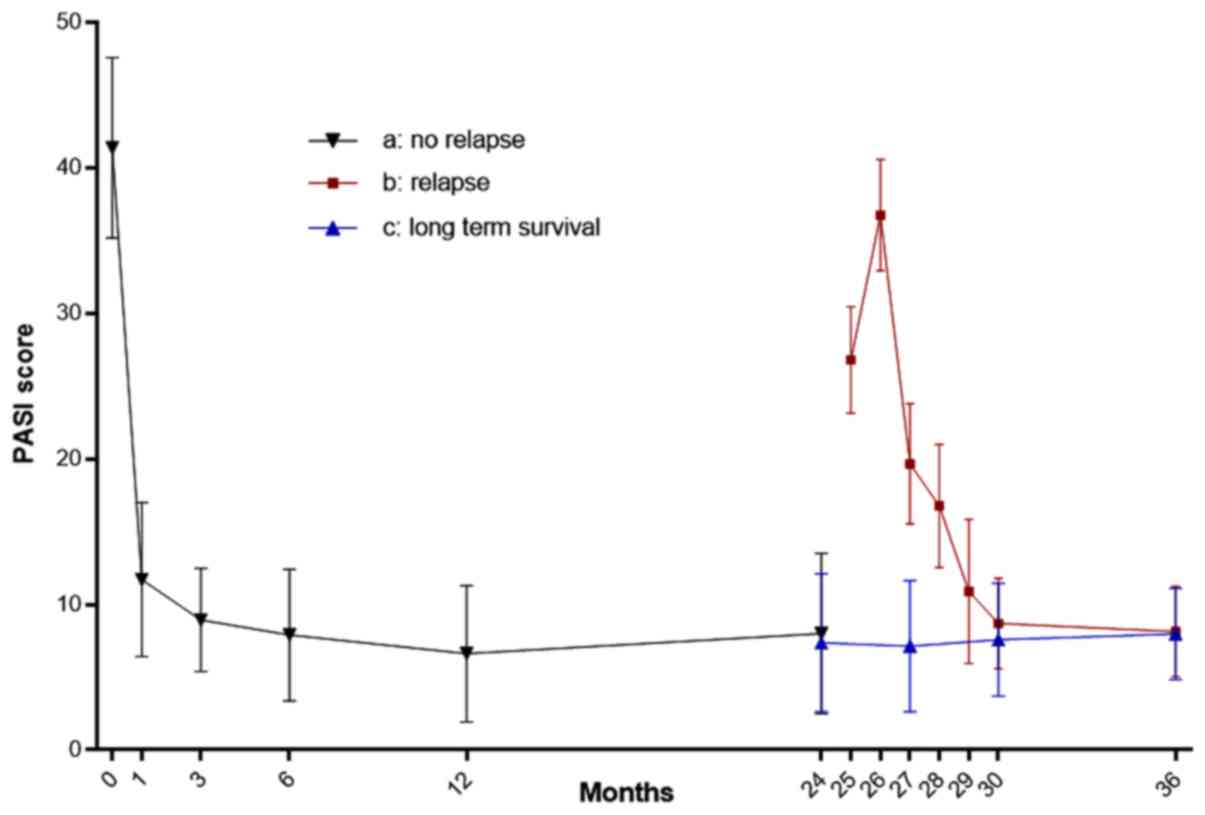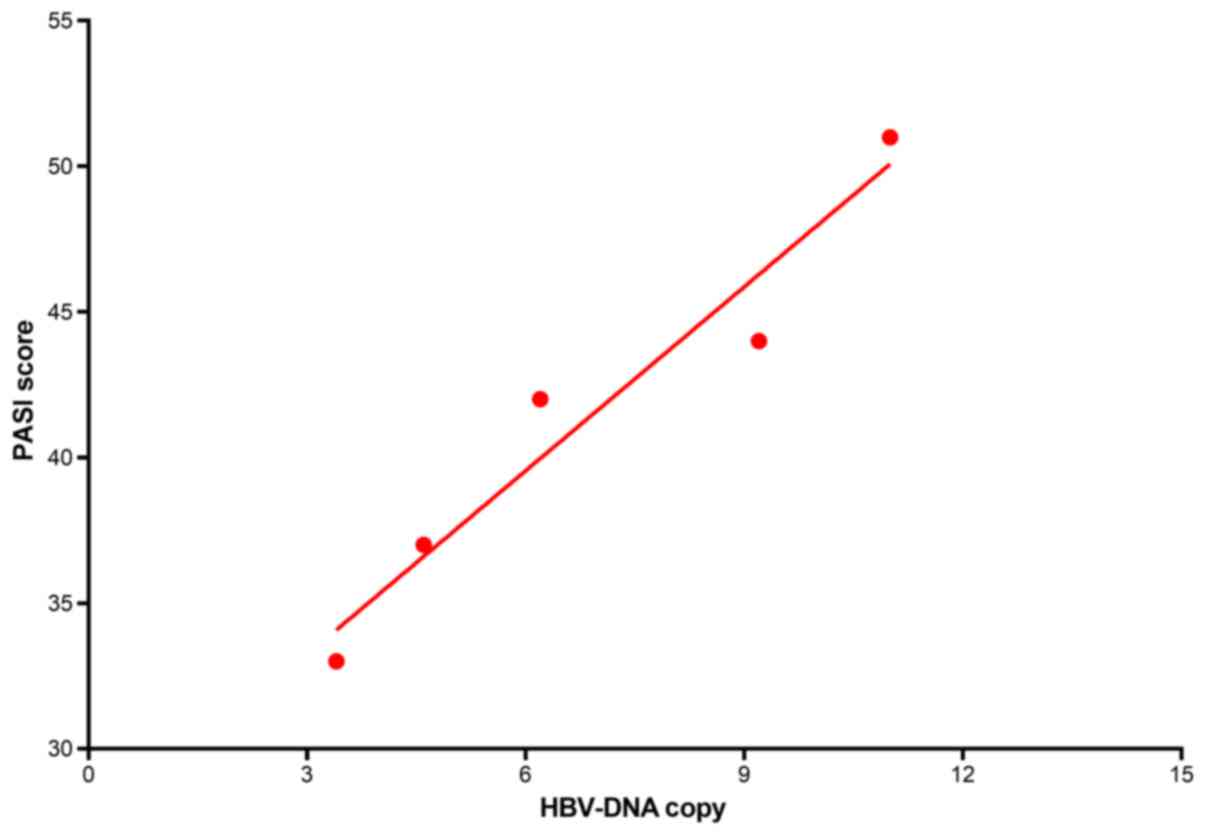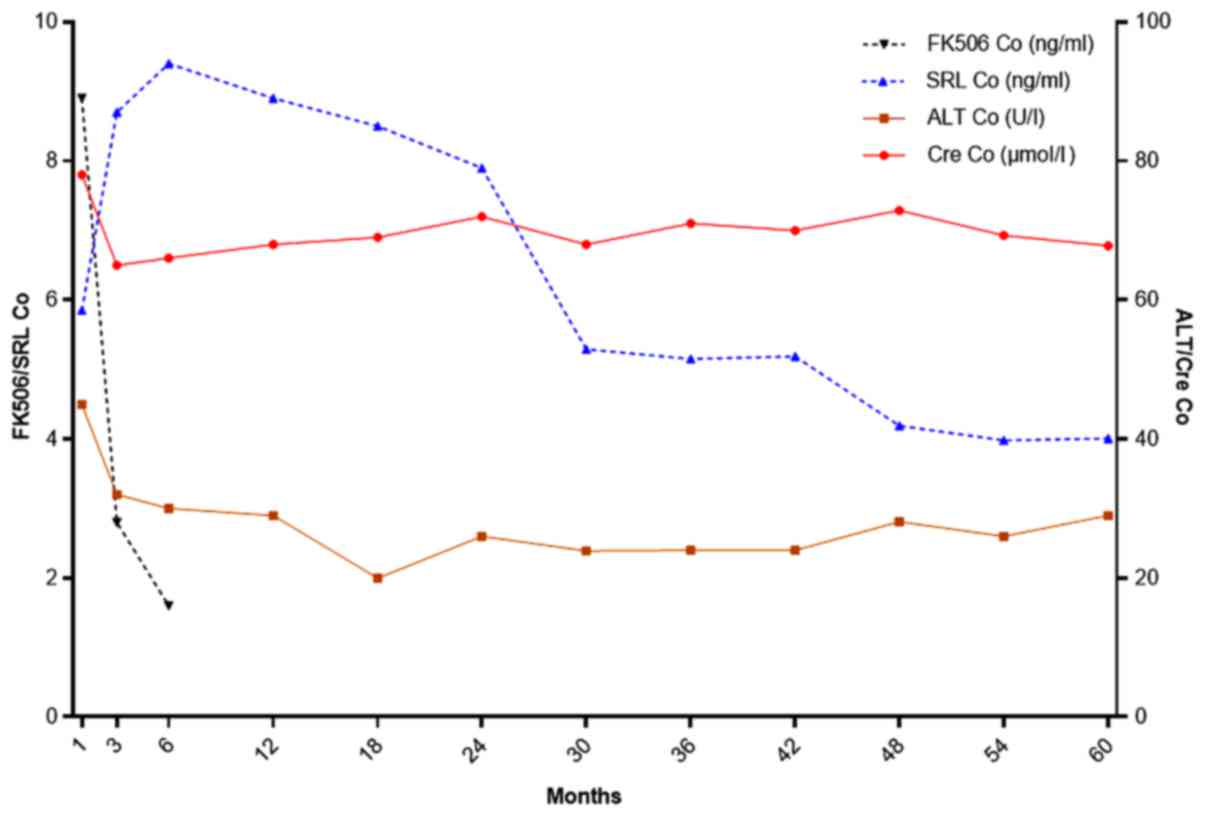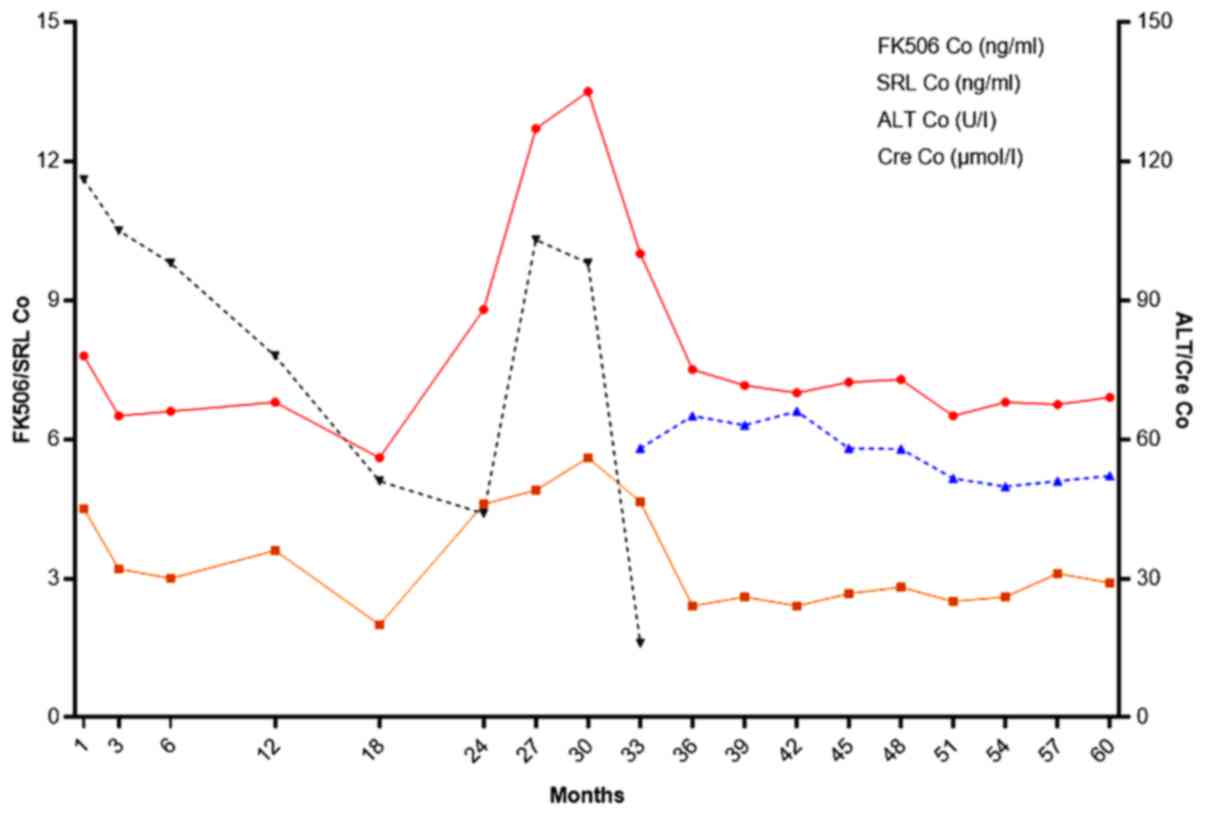|
1
|
Lowes MA, Suárez-Fariñas M and Krueger JG:
Immunology of psoriasis. Annu Rev Immunol. 32:227–255. 2014.
View Article : Google Scholar : PubMed/NCBI
|
|
2
|
Menter A, Korman NJ, Elmets CA, Feldman
SR, Gelfand JM, Gordon KB, Gottlieb A, Koo JY, Lebwohl M, Lim HW,
et al: Guidelines of care for the management of psoriasis and
psoriatic arthritis. Section 3. Guidelines of care for the
management and treatment of psoriasis with topical therapies. J Am
Acad Dermatol. 60:643–659. 2009. View Article : Google Scholar : PubMed/NCBI
|
|
3
|
Schommer NN and Gallo RL: Structure and
function of the human skin microbiome. Trends Microbiol.
21:660–668. 2013. View Article : Google Scholar : PubMed/NCBI
|
|
4
|
Diani M, Altomare G and Reali E: T cell
responses in psoriasis and psoriatic arthritis. Autoimmun Rev.
14:286–292. 2015. View Article : Google Scholar : PubMed/NCBI
|
|
5
|
Madankumar R, Teperman LW and Stein JA:
Use of etanercept for psoriasis in a liver transplant recipient.
JAAD Case Rep. 1:S36–S37. 2015. View Article : Google Scholar : PubMed/NCBI
|
|
6
|
Diani M, Altomare G and Reali E: T Helper
Cell Subsets in Clinical Manifestations of Psoriasis. J Immunol
Res. 2016:76920242016. View Article : Google Scholar : PubMed/NCBI
|
|
7
|
Lowes MA, Russell CB, Martin DA, Towne JE
and Krueger JG: The IL-23/T17 pathogenic axis in psoriasis is
amplified by keratinocyte responses. Trends Immunol. 34:174–181.
2013. View Article : Google Scholar : PubMed/NCBI
|
|
8
|
Kolios AG, Yawalkar N, Anliker M, Boehncke
WH, Borradori L, Conrad C, Gilliet M, Häusermann P, Itin P,
Laffitte E, et al: Swiss S1 guidelines on the systemic treatment of
psoriasis vulgaris. Dermatology. 232:385–406. 2016. View Article : Google Scholar : PubMed/NCBI
|
|
9
|
Quesada JR and Gutterman JU: Psoriasis and
alpha-interferon. Lancet. 1:1466–1468. 1986. View Article : Google Scholar : PubMed/NCBI
|
|
10
|
Baker BS, Griffiths CE, Lambert S, Powles
AV, Leonard JN, Valdimarsson H and Fry L: The effects of
cyclosporine A on T lymphocyte and dendritic cell subpopulations in
psoriasis. Transplant Proc. 20 3 Suppl 4:S72–S77. 1988.
|
|
11
|
Balato A, Schiattarella M, Di Caprio R,
Lembo S, Mattii M, Balato N and Ayala F: Effects of adalimumab
therapy in adult subjects with moderate-to-severe psoriasis on Th17
pathway. J Eur Acad Dermatol Venereol. 28:1016–1124. 2014.
View Article : Google Scholar : PubMed/NCBI
|
|
12
|
Foroncewicz B, Mucha K, Lerut J, Majewski
S, Krawczyk M and Pączek L: Cyclosporine is superior to tacrolimus
in liver transplant recipients with recurrent psoriasis. Ann
Transplant. 19:427–433. 2014. View Article : Google Scholar : PubMed/NCBI
|
|
13
|
Yang ZS, Lin NN, Li L and Li Y: The effect
of TNF inhibitors on cardiovascular events in psoriasis and
psoriatic arthritis: An updated meta-analysis. Clin Rev Allergy
Immunol. 51:240–247.. 2016. View Article : Google Scholar : PubMed/NCBI
|
|
14
|
Krueger GG and Duvic M: Epidemiology of
psoriasis: Clinical issues. J Invest Dermatol. 102:14S–18S. 1994.
View Article : Google Scholar : PubMed/NCBI
|
|
15
|
Asadullah K, Prösch S, Audring H,
Büttnerova I, Volk HD, Sterry W and Döcke WD: A high prevalence of
cytomegalovirus antigenaemia in patients with moderate to severe
chronic plaque psoriasis: An association with systemic tumour
necrosis factor alpha overexpression. Br J Dermatol. 141:94–102.
1999. View Article : Google Scholar : PubMed/NCBI
|
|
16
|
Mehraein Y, Lennerz C, Ehlhardt S, Zang KD
and Madry H: Replicative multivirus infection with cytomegalovirus,
herpes simplex virus 1, and parvovirus B19, and latent Epstein-Barr
virus infection in the synovial tissue of a psoriatic arthritis
patient. J Clin Virol. 31:25–31. 2004. View Article : Google Scholar : PubMed/NCBI
|
|
17
|
Quintin E, Scoazec JY, Marotte H and
Miossec P: Rare incidence of methotrexate-specific lesions in liver
biopsy of patients with arthritis and elevated liver enzymes.
Arthritis Res Ther. 12:R1432010. View
Article : Google Scholar : PubMed/NCBI
|
|
18
|
Howel D, Fischbacher CM, Bhopal RS, Gray
J, Metcalf JV and James OF: An exploratory population based
case-control study of primary biliary cirrhosis. Hepatology.
31:1055–1060. 2000. View Article : Google Scholar : PubMed/NCBI
|
|
19
|
Prince MI, Ducker SI and James OF:
Case-control studies of risk factors for primary biliary cirrhosis
in two United Kingdom populations. Gut. 59:508–512. 2010.
View Article : Google Scholar : PubMed/NCBI
|
|
20
|
Reich K, Burden AD, Eaton JN and Hawkins
NS: Efficacy of biologics in the treatment of moderate to severe
psoriasis: A network meta-analysis of randomized controlled trials.
Br J Dermatol. 166:179–188. 2012. View Article : Google Scholar : PubMed/NCBI
|
|
21
|
Collazo MH, González JR and Torres EA:
Etanercept therapy for psoriasis in a patient with concomitant
hepatitis C and liver transplant. P R Health Sci J. 27:346–347.
2008.PubMed/NCBI
|
|
22
|
Hoover WD: Etanercept therapy for severe
plaque psoriasis in a patient who underwent a liver transplant.
Cutis. 80:211–214. 2007.PubMed/NCBI
|
|
23
|
Steglich RB, Meneghello LP, Carvalho AV,
Cheinquer H, Muller FM and Reginatto F: The use of ustekinumab in a
patient with severe psoriasis and positive HBV serology. An Bras
Dermatol. 89:652–654. 2014. View Article : Google Scholar : PubMed/NCBI
|
|
24
|
Cho YT, Chen CH, Chiu HY and Tsai TF: Use
of anti-tumor necrosis factor-α therapy in hepatitis B virus
carriers with psoriasis or psoriatic arthritis: a case series in
Taiwan. Dermatol. 39:269–273. 2012. View Article : Google Scholar
|
|
25
|
Cassano N, Mastrandrea V, Principi M,
Loconsole F, De Tullio N, Di Leo A and Vena GA: Anti-tumor necrosis
factor treatment in occult hepatitis B virus infection: a
retrospective analysis of 62 patients with psoriatic disease. J
Biol Regul Homeost Agents. 25:285–289. 2011.PubMed/NCBI
|
|
26
|
Balato A, Caprio RD, Lembo S, Mattii M,
Megna M, Schiattarella M, Tarantino G, Balato N, Ayala F and
Monfrecola G: Mammalian Target of Rapamycin in Inflammatory Skin
Conditions. European Journal of Inflammation. 12:341–350. 2014.
View Article : Google Scholar
|
|
27
|
Balato A, Lembo S, Ayala F, Balato N,
Caiazzo G, Raimondo A, Di Caprio R and Monfrecola G: Mechanistic
target of rapamycin complex 1 is involved in psoriasis and
regulated by anti-TNF-α treatment. Exp Dermatol. 26(4): 325–327.
2017. View Article : Google Scholar : PubMed/NCBI
|
|
28
|
Geissler EK, Schnitzbauer AA, Zülke C,
Lamby PE, Proneth A, Duvoux C, Burra P, Jauch KW, Rentsch M and
Ganten TM: Sirolimus use in liver transplant recipients with
hepatocellular carcinoma: A randomized, multicenter, open-label
phase 3 trial. Transplantation. 100:116–125. 2016. View Article : Google Scholar : PubMed/NCBI
|
|
29
|
Lythgoe M and Abraham S: Tacrolimus: an
effective treatment in refractory psoriatic arthritis following
biologic failure. Clin Exp Rheumatol. 34:S12–S13. 2016.PubMed/NCBI
|
|
30
|
Wei KC and Lai PC: Combination of
everolimus and tacrolimus: a potentially effective regimen for
recalcitrant psoriasis. Dermatol Ther. 28:25–27. 2015. View Article : Google Scholar : PubMed/NCBI
|
|
31
|
Tirado-Sánchez A and Ponce-Olivera RM:
Preliminary study of the efficacy and tolerability of combination
therapy with calcipotriene ointment 0.005% and tacrolimus ointment
0.1% in the treatment of stable plaque psoriasis. Cutis.
90:140–144. 2012.PubMed/NCBI
|
|
32
|
Laino L and Di Carlo A: Palmoplantar
pustular psoriasis: clinical and video thermographic evaluation
before and after topical tacrolimus treatment. Arch Dermatol.
147:7602011. View Article : Google Scholar : PubMed/NCBI
|
|
33
|
Foroncewicz B, Mucha K, Paczek L,
Oldakowska-Jedynak U, Górnicka B, Zieniewicz K, Nyckowski P and
Krawczyk M: Anti-CD25 and tacrolimus therapy may not prevent early
primary biliary cirrhosis recurrence after liver transplantation:
two case reports. Transplant Proc. 35:pp. 2310–2312. 2003,
View Article : Google Scholar : PubMed/NCBI
|
|
34
|
Gilbert SC, Klintmalm G, Menter A and
Silverman A: Methotrexate-induced cirrhosis requiring liver
transplantation in three patients with psoriasis. a word of caution
in light of the expanding use of this ‘steroid-sparing’ agent. Arch
Intern Med. 150:889–891. 1990. View Article : Google Scholar : PubMed/NCBI
|
|
35
|
Abu-Elmagd K, Van Thiel D, Jegasothy BV,
Ackerman CD, Todo S, Fung JJ, Thomson AW and Starzl TE: FK506: a
new therapeutic agent for severe recalcitrant psoriasis. Transplant
Proc. 23:3322–3324. 1991.PubMed/NCBI
|















